Generalized Petersen graph
In graph theory, the generalized Petersen graphs are a family of cubic graphs formed by connecting the vertices of a regular polygon to the corresponding vertices of a star polygon. They include the Petersen graph and generalize one of the ways of constructing the Petersen graph. The generalized Petersen graph family was introduced in 1950 by H. S. M. Coxeter[1] and was given its name in 1969 by Mark Watkins.[2]
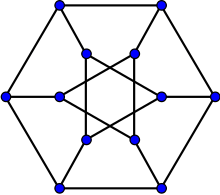
Definition and notation
In Watkins' notation, G(n, k) is a graph with vertex set
and edge set
where subscripts are to be read modulo n and k < n/2. Some authors use the notation GPG(n, k). Coxeter's notation for the same graph would be {n} + {n/k}, a combination of the Schläfli symbols for the regular n-gon and star polygon from which the graph is formed. The Petersen graph itself is G(5, 2) or {5} + {5/2}.
Any generalized Petersen graph can also be constructed from a voltage graph with two vertices, two self-loops, and one other edge.[3]
Examples
Among the generalized Petersen graphs are the n-prism G(n, 1), the Dürer graph G(6, 2), the Möbius-Kantor graph G(8, 3), the dodecahedron G(10, 2), the Desargues graph G(10, 3) and the Nauru graph G(12, 5).
Four generalized Petersen graphs – the 3-prism, the 5-prism, the Dürer graph, and G(7, 2) – are among the seven graphs that are cubic, 3-vertex-connected, and well-covered (meaning that all of their maximal independent sets have equal size).[4]
Properties
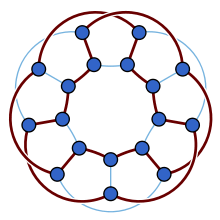
This family of graphs possesses a number of interesting properties. For example:
- G(n, k) is vertex-transitive (meaning that it has symmetries that take any vertex to any other vertex) if and only if (n, k) = (10, 2) or k2 ≡ ±1 (mod n).
- G(n, k) is edge-transitive (having symmetries that take any edge to any other edge) only in the following seven cases: (n, k) = (4, 1), (5, 2), (8, 3), (10, 2), (10, 3), (12, 5), (24, 5).[5] These seven graphs are therefore the only symmetric generalized Petersen graphs.
- G(n, k) is bipartite if and only if n is even and k is odd.
- G(n, k) is a Cayley graph if and only if k2 ≡ 1 (mod n).
- G(n, k) is hypohamiltonian when n is congruent to 5 modulo 6 and k = 2, n − 2, or (n ± 1)/2 (these four choices of k lead to isomorphic graphs). It is also non-Hamiltonian when n is divisible by 4, at least equal to 8, and k = n/2. In all other cases it has a Hamiltonian cycle.[6] When n is congruent to 3 modulo 6 G(n, 2) has exactly three Hamiltonian cycles.[7] For G(n, 2), the number of Hamiltonian cycles can be computed by a formula that depends on the congruence class of n modulo 6 and involves the Fibonacci numbers.[8]
- Every generalized Petersen graph is a unit distance graph.[9]
Isomorphisms
G(n, k) is isomorphic to G(n, l) if and only if kl ≡ 1 (mod n).[10]
Girth
The girth of G(n, k) is at least 3 and at most 8, in particular:[11]
A table with exact girth values:
Condition Girth 3 4 5 6 7 otherwise 8
Chromatic number and chromatic index
Being regular, according to Brooks' theorem their chromatic number can not be larger than their degree. Generalized Petersen graphs are cubic, so their chromatic number can be either 2 or 3. More exactly:
Where denotes the logical AND, while the logical OR. For example, the chromatic number of is 3.
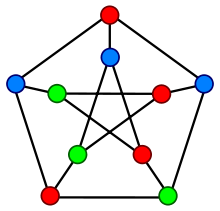 A 3-coloring of the Petersen graph or
A 3-coloring of the Petersen graph or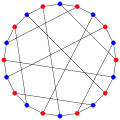 A 2-coloring of the Desargues graph or
A 2-coloring of the Desargues graph or A 3-coloring of the Dürer graph or
A 3-coloring of the Dürer graph or
Petersen graph, being a snark, has a chromatic index of 4. All other generalized Petersen graph has chromatic index 3.[12]
The generalized Petersen graph G(9, 2) is one of the few graphs known to have only one 3-edge-coloring.[13]
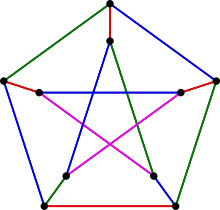 A 4-edge-coloring of the Petersen graph or
A 4-edge-coloring of the Petersen graph or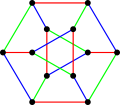 A 3-edge-coloring of the Dürer graph or
A 3-edge-coloring of the Dürer graph or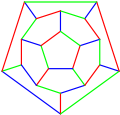 A 3-edge-coloring of the dodecahedron or
A 3-edge-coloring of the dodecahedron or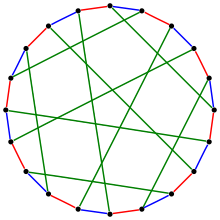 A 3-edge-coloring of the Desargues graph or
A 3-edge-coloring of the Desargues graph or%3B_matrices.svg.png) A 3-edge-coloring of the Nauru graph or
A 3-edge-coloring of the Nauru graph or
The Petersen graph itself is the only generalized Petersen graph that is not 3-edge-colorable.[14]
References
- Coxeter, H. S. M. (1950), "Self-dual configurations and regular graphs", Bulletin of the American Mathematical Society, 56 (5): 413–455, doi:10.1090/S0002-9904-1950-09407-5.
- Watkins, Mark E. (1969), "A Theorem on Tait Colorings with an Application to the Generalized Petersen Graphs", Journal of Combinatorial Theory, 6 (2): 152–164, doi:10.1016/S0021-9800(69)80116-X.
- Gross, Jonathan L.; Tucker, Thomas W. (1987), Topological Graph Theory, New York: Wiley. Example 2.1.2, p.58.
- Campbell, S. R.; Ellingham, M. N.; Royle, Gordon F. (1993), "A characterisation of well-covered cubic graphs", Journal of Combinatorial Mathematics and Combinatorial Computing, 13: 193–212, MR 1220613.
- Frucht, R.; Graver, J. E.; Watkins, M. E. (1971), "The groups of the generalized Petersen graphs", Proceedings of the Cambridge Philosophical Society, 70 (2): 211–218, doi:10.1017/S0305004100049811.
- Alspach, B. R. (1983), "The classification of Hamiltonian generalized Petersen graphs", Journal of Combinatorial Theory, Series B, 34 (3): 293–312, doi:10.1016/0095-8956(83)90042-4, MR 0714452.
- Thomason, Andrew (1982), "Cubic graphs with three Hamiltonian cycles are not always uniquely edge colorable", Journal of Graph Theory, 6 (2): 219–221, doi:10.1002/jgt.3190060218.
- Schwenk, Allen J. (1989), "Enumeration of Hamiltonian cycles in certain generalized Petersen graphs", Journal of Combinatorial Theory, Series B, 47 (1): 53–59, doi:10.1016/0095-8956(89)90064-6, MR 1007713.
- Žitnik, Arjana; Horvat, Boris; Pisanski, Tomaž (2010), All generalized Petersen graphs are unit-distance graphs (PDF), IMFM preprints, 1109.
- Steimle, Alice; Staton, William (2009), "The isomorphism classes of the generalized Petersen graphs", Discrete Mathematics, 309 (1): 231–237, doi:10.1016/j.disc.2007.12.074
- Ferrero, Daniela; Hanusch, Sarah (2014), "Component connectivity of generalized Petersen graphs" (PDF), International Journal of Computer Mathematics, 91 (9): 1940–1963, doi:10.1080/00207160.2013.878023, ISSN 0020-7160, archived from the original (PDF) on 2018-10-20, retrieved 2018-10-20
- Castagna, Frank; Prins, Geert Caleb Ernst (1972), "Every generalized Petersen graph has a Tait coloring", Pacific Journal of Mathematics, 40 (1): 53–58, doi:10.2140/pjm.1972.40.53, ISSN 0030-8730, MR 0304223, Zbl 0236.05106
- Bollobás, Béla (2004), Extremal Graph Theory, Dover, p. 233. Reprint of 1978 Academic Press edition.
- Castagna, Frank; Prins, Geert (1972), "Every Generalized Petersen Graph has a Tait Coloring", Pacific Journal of Mathematics, 40: 53–58, doi:10.2140/pjm.1972.40.53.